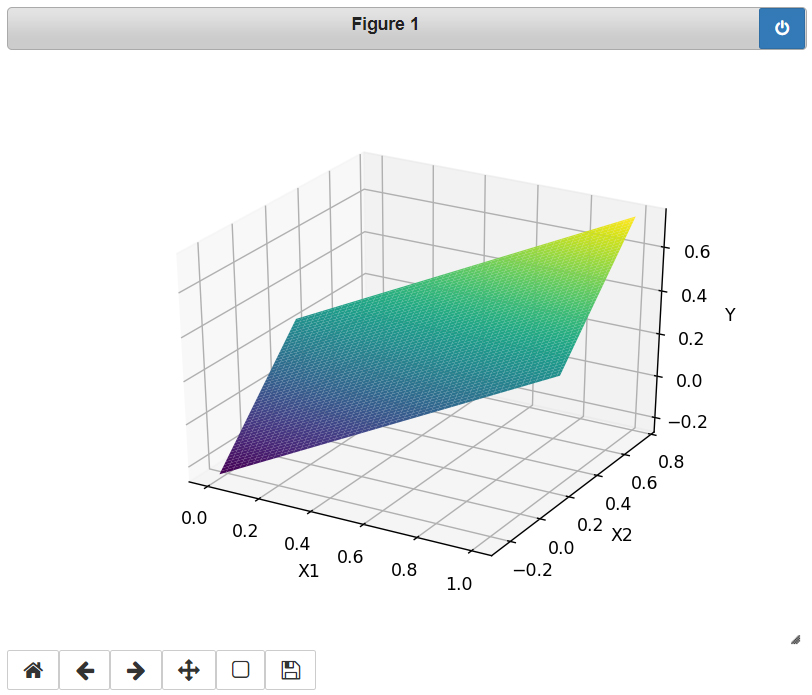TF2.1でAND回路
2020.04.26
Jupyter 起動
さっそくTensorflow 2.1を動かしてみます。PowerShellを起動して、Jupyterを起動させます。
> jupyter notebook

右上のNewからPython 3を選択。
バージョン情報
ノートブックの頭に使用したバージョンなどをメモしておくとバージョン変えた時に便利です。
import sys import tensorflow as tf import numpy as np print('Python:', sys.version) print('Tensorflow:', tf.__version__) print('Keras:', tf.keras.__version__) print('numpy:', np.__version__)
Shift+Enter キーを押して実行すると以下のように表示されます。
Python: 3.7.6 (default, Jan 8 2020, 20:23:39) [MSC v.1916 64 bit (AMD64)] Tensorflow: 2.1.0 Keras: 2.2.4-tf numpy: 1.18.1
TF2.1でモデル化
ここでは単純な、で判定させるモデルを作ります。Denseで2次元のデータを1次元にします。
TF2.xからKerasがフロントエンドとなったのでplaceholderとかVariableがなくなります。TF1.xのときと比べるとimportの場所が若干変わってますね。kerasがtensorflowの中に組み込まれたのでtensorflow.kerasの中にモジュールが含まれています。
さて以下を実行してみましょう。loss(誤差)が徐々に減り期待した値に近づいていることがわかります。
(ここで実行できない人はインストールするツールのバージョンが合っていないかと思われます)
import numpy as np import tensorflow as tf from tensorflow.keras import Input from tensorflow.keras.layers import Dense from tensorflow.keras import Model from tensorflow.keras.optimizers import SGD, Adam trainX = np.array([ [0.0, 0.0], [1.0, 0.0], [0.0, 1.0], [1.0, 1.0]]) trainY = np.array([ 0.0, 0.0, 0.0, 1.0 ]) x_in = Input(shape=(2,)) x = x_in x = Dense(1, use_bias=True, activation=None)(x) model = Model(x_in, x) learning_rate = 0.1 sgd = SGD(lr=learning_rate) model.compile(optimizer=sgd, loss='mean_squared_error') model.summary() batch_size = 4 history = model.fit(x=trainX, y=trainY, epochs=1000, batch_size=batch_size, shuffle=False, validation_split=0.0) evaluate = model.evaluate(trainX, trainY) print('Evaluate:', evaluate) testX = trainX output = model.predict(testX[0:batch_size]) print('Predict:', output)
以下のようになりました。(1, 1)のときに一番大きな値が出力されています。正確に1とならないのはでは完全にモデル化できないからです。
Model: "model" _________________________________________________________________ Layer (type) Output Shape Param # ================================================================= input_1 (InputLayer) [(None, 2)] 0 _________________________________________________________________ dense (Dense) (None, 1) 3 ================================================================= Total params: 3 Trainable params: 3 Non-trainable params: 0 _________________________________________________________________ Train on 4 samples Epoch 1/1000 4/4 [==============================] - 1s 143ms/sample - loss: 0.5787 Epoch 2/1000 4/4 [==============================] - 0s 749us/sample - loss: 0.3331 (略) Evaluate: 0.0625 Predict: [[-0.25000072] [ 0.24999994] [ 0.24999994] [ 0.7500006 ]]
係数出力
係数を出力するには以下のようにします。
def PrintWeights(model): print('-----Weights-----') for i, l in enumerate(model.layers): weights = l.get_weights() if len(weights) == 0: continue name = ['W', 'b'] for j, c in enumerate(weights): print('{}:{}'.format(name[j], c)) print('-----------------') PrintWeights(model)
結果は以下のようになりました。つまり、がAND回路になるようにフィッティング(学習)されたということになります。
-----Weights----- W:[[0.50000066] [0.50000066]] b:[-0.25000072] -----------------
さて、せっかくなのでがどのような面をしているのか表示してみましょう。
は0,1以外の値も入れることができます(どういう風に解釈するかはお任せします)。
import numpy as np import matplotlib.pyplot as plt from mpl_toolkits.mplot3d import axes3d %matplotlib notebook x1 = np.linspace(0, 1, 100) x2 = np.linspace(0, 1, 100) X1, X2 = np.meshgrid(x1, x2) W = model.layers[1].get_weights()[0] b = model.layers[1].get_weights()[1] Y = X1 * W[0, 0] + X2 * W[1, 0] + b fig = plt.figure() ax = fig.gca(projection='3d') ax.plot_surface(X1, X2, Y, cmap=plt.cm.viridis) ax.set_xlabel('X1') ax.set_ylabel('X2') ax.set_zlabel('Y') plt.show()

ORにしたい人は次のようにしてみましょう。
trainX = np.array([
[0.0, 0.0],
[1.0, 0.0],
[0.0, 1.0],
[1.0, 1.0]])
trainY = np.array([
0.0,
1.0,
1.0,
1.0
])
次回はXOR回路を見てみます。